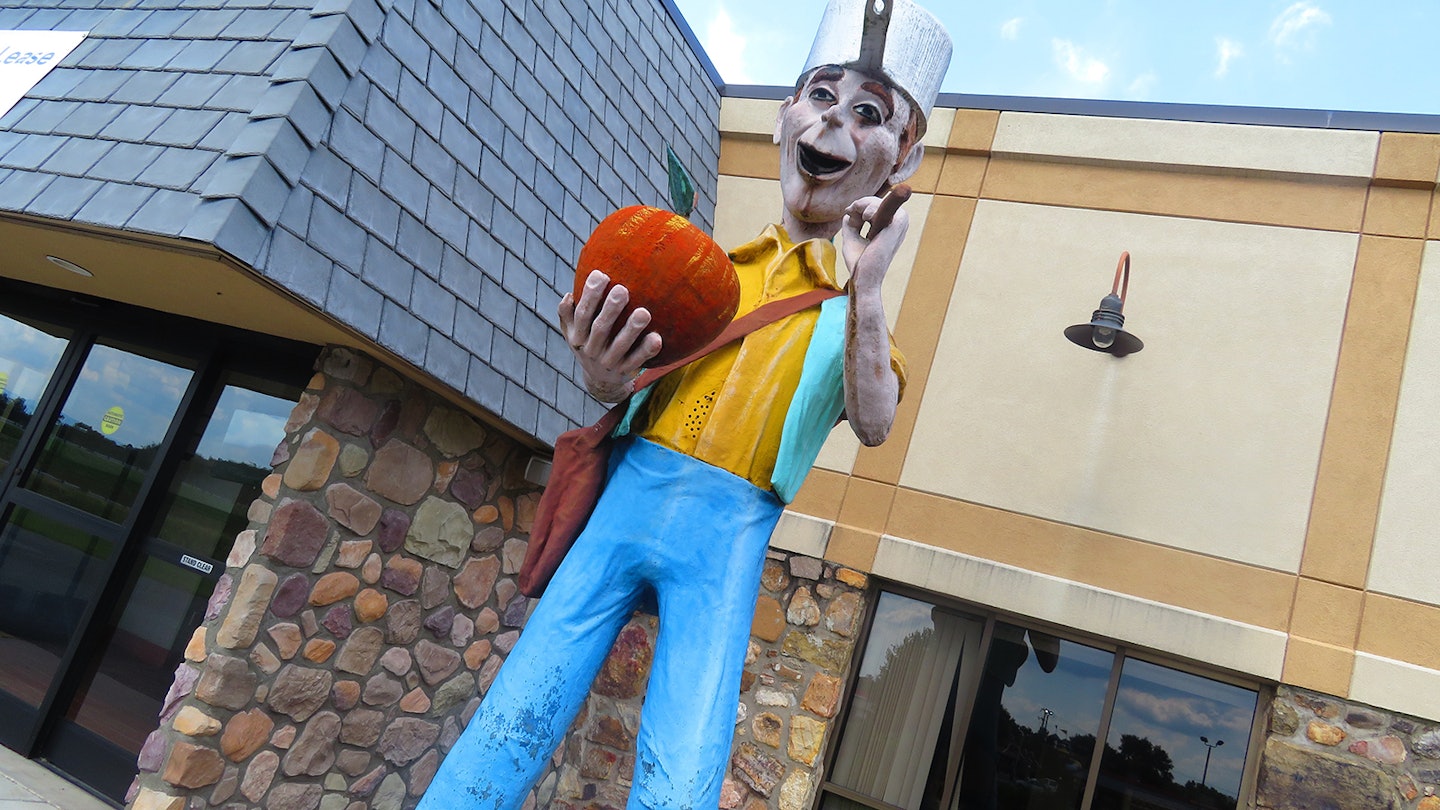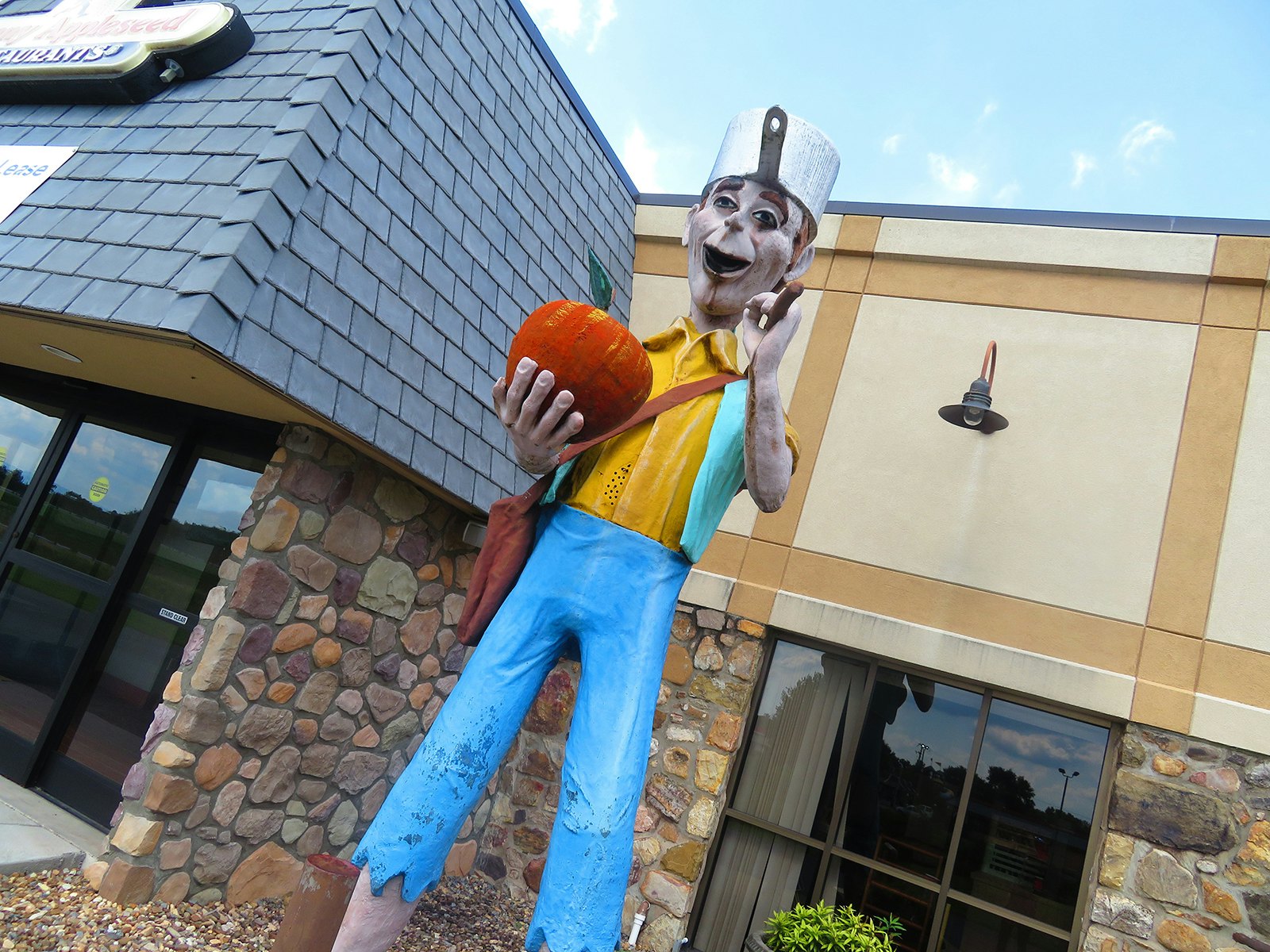Seeing is believing: top roadside attractions in the Shenandoah Valley

Oct 12, 2018 • 7 min read

off-center photo of a statue of folk hero Johnny Appleseed, which stands 14ft tall. He's wearing blue pants, a yellow shirt and a frying pan hat – and he's carrying an apple.
West of Washington DC, Virginia’s Shenandoah Valley is a picture-perfect realm of history-filled villages, apple orchards and breathtaking mountain scenery. But throughout this noble green valley you’ll also find some unexpected sights, including the world’s largest musical instrument and a larger-than-life Johnny Appleseed. Some of these stranger-than-fiction quirky attractions have to be seen to be believed, so get packing.

A larger-than-life Johnny Appleseed
A 15ft-tall, barefoot Johnny Appleseed, with a pot on his head, stands outside a defunct restaurant in New Market. One of many odd characters sprinkling the Shenandoah Valley landscape, the statue’s presence here is even quirkier if you consider the fact that this American folk hero – a real-life person who is credited with planting apple trees around the United States – was never anywhere near the Shenandoah Valley. You’ll also find a giant watering can and flower pots in Staunton, an enormous apple with Stonewall Jackson’s visage painted on the front in Winchester, a purple cow head at Purple Cow Ice Cream Parlor near Waynesboro, a larger-than-life-size hog in New Market, a building shaped like a coffee pot in Lexington, among other whimsical and surprising statues.

The great stalacpipe organ
Deep inside the earth, music soars through the cavernous, stalactite-punctuated space of the Cathedral Room at Luray Caverns. The pure, symphonic tones evoke “A Mighty Fortress Is Our God,” one of Leland W. Sprinkle’s favorite songs. Wait, who’s he? The mathematician, scientist and musician who invented this “stalacpipe” organ, of course – the world’s largest musical instrument. Back in the 1950s, Mr Sprinkle wired this 3.5-acre space, connecting a console with rubber-tipped mallets that, when played, gently strike one of 37 corresponding, perfectly pitched stalactites. In all reality, it’s not really an organ; it’s a percussion instrument called a lithophone. But as you’re listening to the gorgeous, organ-like sounds resonate through the subterranean landscape, you won’t care.
A natural rock bridge once owned by Thomas Jefferson
A young George Washington surveyed an immense limestone bridge soaring over Cedar Creek south of Lexington (and supposedly carved his initials in the rock), and Thomas Jefferson admired it so much, he bought it from King George III in 1774. In its day, Natural Bridge ranked with Niagara Falls as the New World’s two natural wonders … until the Grand Canyon, Yellowstone’s geysers and others came along. In 2016 the 20-story natural formation – along with 1,500 acres of surrounding land that incorporate hiking trails, a Monacan Indian living history village, caverns and a hotel and conference center – became a state park.

A country singer’s tiny bathroom
In a quiet, working-class neighborhood in Winchester sits a modest, white-frame, two-story house that doesn’t look like anything special. Look inside and you’ll see that the tiny bathroom crammed under the stairs has just enough room for a toilet – there’s no sink, shower or tub. No wonder townspeople would see Ginny Hensley, who moved there in 1948 with her sister, brother and single mother, wandering about town in her curlers: there just wasn’t a lot of space for primping. Even so, young Ginny was on her way to becoming trailblazing country singer Patsy Cline, known for such mournful hits as 'Crazy' and 'Walkin’ After Midnight.' After winning 'Arthur Godfrey’s Talent Scouts' in 1957 (the 'American Idol' of the day) and making her way to the Grand Ole Opry, Cline died in a tragic plane crash in 1963 at the age of 30. She’s buried in the nearby Shenandoah Memorial Park, and her small but cozy house is now a museum looking almost exactly as it did when she lived here.
The General Lee
Even though the show took place in Georgia, you’d be forgiven if you turn off Route 340 in New Market and think you’ve stumbled across the TV set of 'The Dukes of Hazzard,' the popular 1980s action comedy starring the Duke brothers, who race around town in their car and invariably become entangled with the crooked-and-corrupt county commissioner Boss Hogg. The orange-red General Lee Dodge Charger is here of course, but there’s also Cooter the mechanic’s tow truck, cousin Daisy’s café and, inside the 'Cooter’s' building, a whole memorabilia-filled museum devoted to the TV show, as well as a replica of Cooter’s garage, including Boss Hogg’s Cadillac. Cooter’s in the Valley is owned by Ben Jones, the show’s original Cooter. And if just seeing all the memorabilia isn’t enough, Jones performs every weekend with his Cooter’s Garage Band featuring special guests, some dating all the way back to the TV show. Check the website to see what’s on tap.

A graveyard of parade floats
Where do the spectacular floats that trundle down Pasadena’s streets during the Rose Bowl go after their service is done? Or the stage settings for Presidential inaugurations? Or any number of other decorations that put the patriotic and whimsical pizzazz in national revelries? The American Celebration on Parade in Shenandoah Caverns, of course. This hangar-size warehouse in Mount Jackson displays about 20-some floats at one time, many of which have dazzled thousands of spectators at the Rose Parade, Thanksgiving Day Parade and other all-American celebrations. Float builder Earl C. Hargrove Jr, who created floats for the country’s biggest political parades since 1949, built the space in 2000. He has since passed away, but his legacy lives on, with plenty of singing ducks, regal eagles, spinning genies and rippling flags. You can’t miss the building – it’s the one with the giant Statue of Liberty in front.
Stonewall Jackson’s mounted horse
Little Sorrel may not have been the most beautiful horse around; some might even have considered him small and gaunt. But Confederate general Thomas “Stonewall” Jackson knew a good horse when he saw one. The duo rode through many a battle together, with Little Sorrel charging ahead. After the war, Little Sorrel made the rounds at county fairs, even guest-appearing at the New Orleans World Fair in 1885. Upon his demise, in 1886, his hide was presented to the Virginia Military Institute Museum in Lexington, where it was draped over a Plaster of Paris form. Little Sorrel remains on display at VMI to this day, next to the raincoat Jackson was wearing when he was killed by friendly fire in 1863 at Chancellorsville.

An epic life-size battle between a titanosaurus and tyrannosaurus
Driving down Route 522 south of Winchester, the last thing you might expect to see is a T. rex – much less an Apatosaurus. But there they are, both of them, standing tall at the intersection with Route 277 in White Post. You have found Dinosaur Land, where more than 40 fiberglass, life-size prehistoric creatures dot the landscape in various imposing poses. It’s the brainchild of one Joseph Geraci, who opened Rebel Corner gift shop here 1963. After spending some time in Florida (and getting to know a Disney World designer), he commissioned five prehistoric creatures for his store. He liked what he saw – and so did his customers – and so, as you can see, the number grew, and grew, and grew. At some point, he renamed the attraction “Dinosaur Land.” It’s not all cheesy reproductions; educational signs provide context for what you’re looking at. Some of the most interesting creatures here include the 13ft-tall giant ground sloth, the Titanosaurus and Tyrannosaurus going at it in an epic battle, and a 20ft-tall King Kong.
A medieval-style jousting contest
Every year, on the third Saturdays in June and August, surrounded by the crenelated limestone formations of Natural Chimneys Regional Park, individuals take part in what claims to be the oldest continuously held sporting event in America (since 1821). We’re talking jousting, that medieval sport that, thankfully in this case, involves skewering three rings on a lance from the back of a horse, not killing the opponent. But that doesn’t mean the competition isn’t fierce. If that’s not enough, there’s also a National Jousting Hall of Fame at the park, complete with a suit of armor, some lances and a mannequin sporting a medieval page outfit, as well as trophies and photos portraying the sport’s early days.



